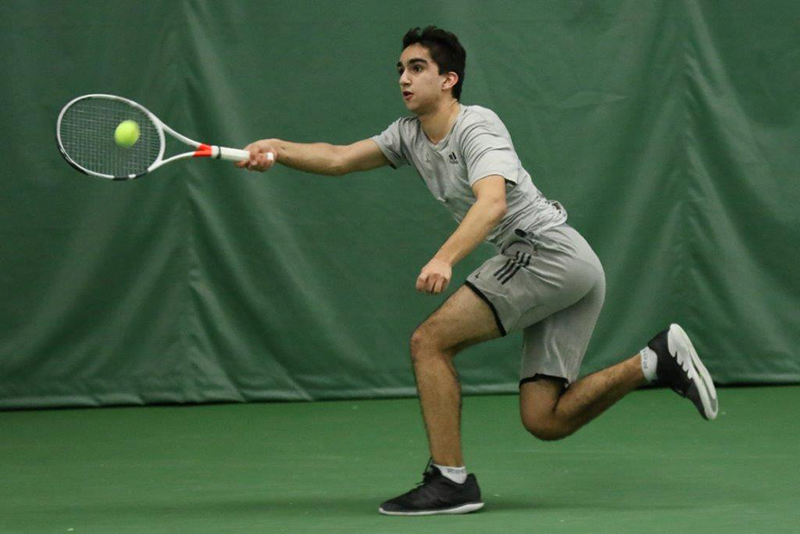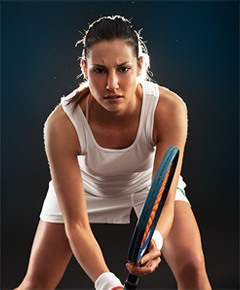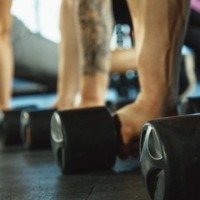We asked our Wellness Practitioner, Chiropractor, former Professional Tennis Player and four-time Canadian Junior National Champion, Dr. Dominique Harmath, for some of her tips for staying pain free on the courts.
Feeling the Weight of the Serve on Your Shoulders?
The average speed of the first serve in professional tennis players ranges between 182-190km/h for men and 155-161km/h for women, with shoulder rotational angular velocities in the acceleration phase of the first serve exceeding 2,500 degrees per second (1,2). These are impressive stats.

What Goes Fast, Must Slow Down.
In this case, it must slow down very quickly to prepare for the return coming back. The deceleration forces acting on the shoulder in the follow through phase of the serve can reach up to 300 newton metres with distraction forces registering 0.5-0.75x a person’s body weight (3).
On average, a player hits 40 serves per set with a 3:1 first to second serve ratio (4). Take that in. Now add the fact that the shoulder is the most mobile joint of the human body (5). Never really considered addressing your shoulder health as a tennis player? I hope I’ve caught your attention.
So what can you do to make sure your shoulder can keep up with your big serves?
1. Have a Mobility Program
Mobility in the Functional Range Conditioning (FRC) framework means a combination of flexibility and control/strength. You want to develop body awareness and motor control in individual joints, in this context the shoulder, to optimize its health and movement. If we are only stretching, we are missing a piece of the puzzle. We want usable movement that we can apply load to. Stretching alone does not ensure that our shoulder has the capacity to actively move with control in that range.
A full body mobility program including the thoracic spine, hips and ankles should also be in place as these are the building blocks of the sequential multi segment movements that occur during serving.
An example of a shoulder mobility exercise that can be performed daily is controlled articular rotations (CARs). Shoulder CARs involve moving the shoulder in a circular, slow, and controlled manner with high effort through its maximal ranges of motion. It does not have to be complicated, but there needs to be intent and commitment. Building tissue resilience takes time.
2. Strength Train for Tennis
Once we have muscular control in various ranges, we want to train the shoulder to have the capacity to withstand the forces it must transfer and generate. Sounds great. How about some push-ups? Not so fast. During the service motion, the shoulder only contributes about 13% of the kinetic energy (6). It does however transfer a significant amount of the energy that was generated from the legs and trunk to the hand (6).
If there is an energy leak from the trunk or legs, other structures higher up in the sequenced service motion (i.e., the shoulder) will have to compensate to attain the same serving velocity (6). This means our strength programs should be focused on much more than some push-ups. We need a full body strength program that prepares you for the physical demands of tennis.
3. Listen to Your Body
If there is fatigue, pain, or discomfort you need to acknowledge it and adjust what you are doing to give your body the attention it needs to recover. What is the best recovery? That is a topic for another day but keep in mind that you know best how your body feels so practice being in tune with it. You are the one person who will be affected by the environment, training, and recovery you create for yourself.
The court is calling.
Learn More
Interested in taking the first step toward your shoulder health through a session with Dr. Harmath?
Please call the Mayfair Lakeshore Sports Clinic at (416) 466-3704. Mayfair Lakeshore is located at 801 Lake Shore Blvd E Toronto, at Lakeshore and DVP. For any inquiries, please reach out to Dr. Harmath at harmath.dominique@gmail.com.
About the Author:

Dr. Dominique Harmath is an evidence-based chiropractor and a sports sciences resident with the Royal College of Chiropractic Sports Sciences Canada (RCCSSC), the most extensive sport specialty training program in the chiropractic profession. She earned her Doctor of Chiropractic degree from Canadian Memorial Chiropractic College (CMCC) in Toronto and is currently a candidate to be a Sports Specialist Chiropractor. Dr. Harmath has received international awards for her research and work in the field. Her passion lies with helping people move better to enhance their quality of life and achieve their sports performance goals. Her approach to care is individualized. She is trained in active release therapy (ART), soft tissue treatment, medical acupuncture, adjustment and joint mobilization, soft tissue tools, rehabilitation, and exercise prescription.
As a former professional tennis player, four-time Canadian Junior National Champion and top 50 Division | NCAA player for Rice University in Houston, Dr. Harmath holds a special interest in biomechanical movement and strategies to reduce injury risk in tennis. She has been a part of the Women’s Tennis Association (WTA) medical team for the Rogers Cup, worked International Tennis Federation (ITF) tournaments, The Pan Am Fencing Championships, The Toronto Triathlon, The Taekwondo Provincial Championships, The Canadian Mountain Bike National Championships, and several other sporting events. She is currently a chiropractor for Alpine Canada’s Men’s Ski World Cup team.
References:
- Frantisek Vaverka & Miroslav Cernosek (2012): Association between body height and serve speed in elite tennis players, Sports Biomechanics, DOI:10.1080/14763141.2012.670664
- Fleisig G, Nicholls R, Elliott B, and Escamilla R. Kinematics used by world class tennis players to produce high velocity serves. Sports Biomech 2(1):51–71, 2002.
- Ellenbecker TS, Roetert EP, Kibler WB, Kovacs MS. Applied biomechanics of tennis. In: Magee DJ, Manske RC, Zachazewski JE, Quillen WS, eds. Athletic and Sports Issues in Musculoskeletal Rehabilitation. St Louis, MO: Saunders; 2010:chap 11.
- Myers NL, Sciascia AD, Kibler WB, Uhl TL. Volume-based Interval Training Program for Elite Tennis Players. Sports Health. 2016 Nov/Dec;8(6):536-540. doi: 10.1177/1941738116657074. Epub 2016 Jul 8. PMID: 27370009; PMCID: PMC5089352.
- Chang LR, Anand P, Varacallo M. Anatomy, Shoulder and Upper Limb, Glenohumeral Joint. [Updated 2020 Aug 10]. In: StatPearls [Internet]. Treasure Island (FL): StatPearls Publishing; 2021 Jan-. Available from: https://www.ncbi.nlm.nih.gov/books/NBK537018/
- Kibler WB. Biomechanical analysis of the shoulder during tennis activities. Clin Sports Med. 1995;14(1):79-85.

Mayfair Clubs
Mayfair Clubs (www.mayfairclubs.com) is a modern sports club with four locations in Toronto, Canada.
Newsletter
Sign up
Join our Mayfair Newsletter for the latest member news, events, contests, promotions and blogs. You may unsubscribe at anytime by clicking the "unsubscribe" link at the bottom of all newsletter emails.
 Lakeshore (416) 466-3777
801 Lake Shore Blvd E Toronto, ON Lakeshore and DVPs
Lakeshore (416) 466-3777
801 Lake Shore Blvd E Toronto, ON Lakeshore and DVPs
 West (416) 638-1010
3855 Chesswood Dr Toronto, ON Sheppard and Dufferin
West (416) 638-1010
3855 Chesswood Dr Toronto, ON Sheppard and Dufferin
 Parkway (905) 475-0350
50 Steelcase Rd. E. Toronto, ON Woodbine and Steeles
Parkway (905) 475-0350
50 Steelcase Rd. E. Toronto, ON Woodbine and Steeles
 East (905) 475-8833
160 Esna Park Dr Markham, ON Denison and Victoria Park
East (905) 475-8833
160 Esna Park Dr Markham, ON Denison and Victoria Park






































